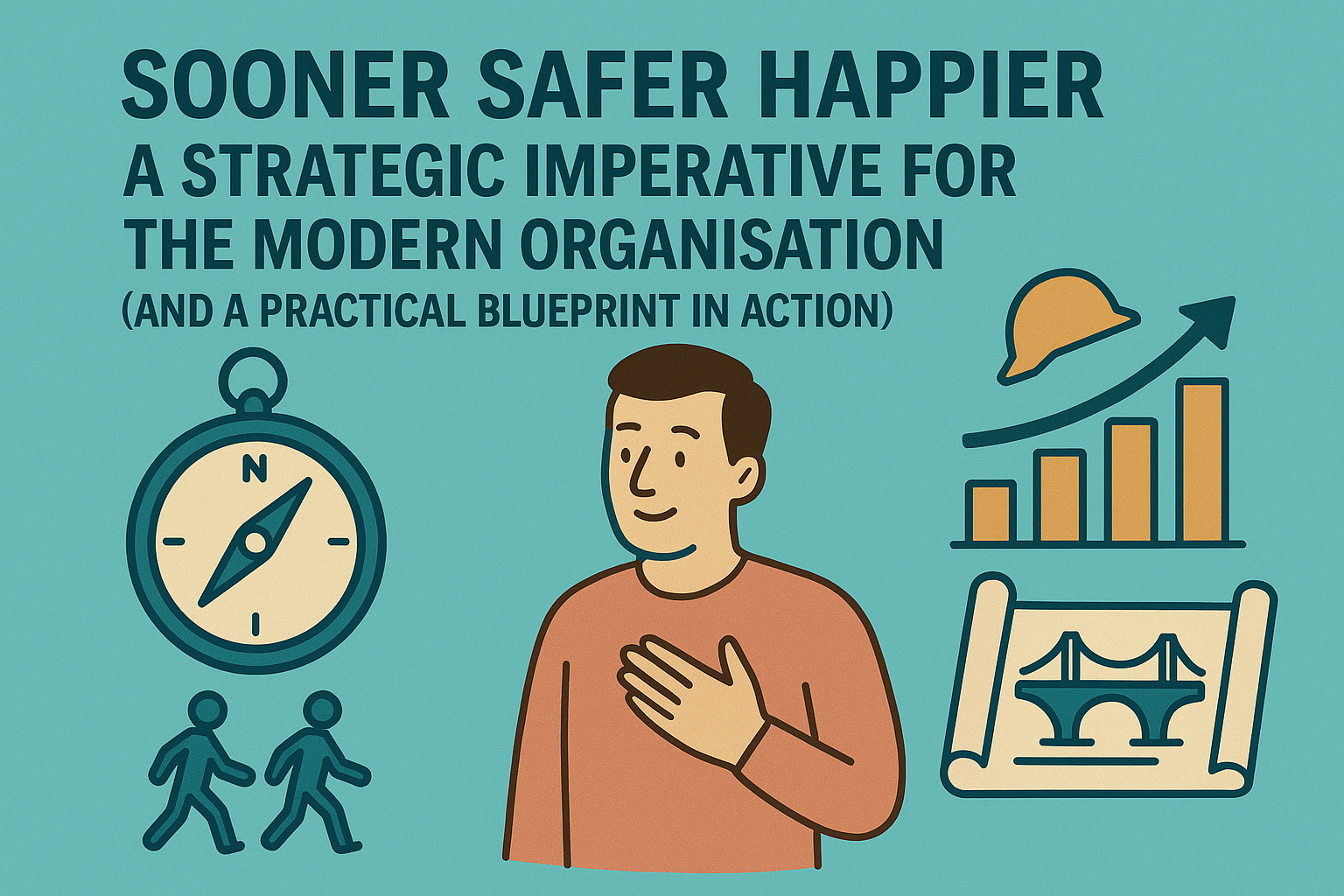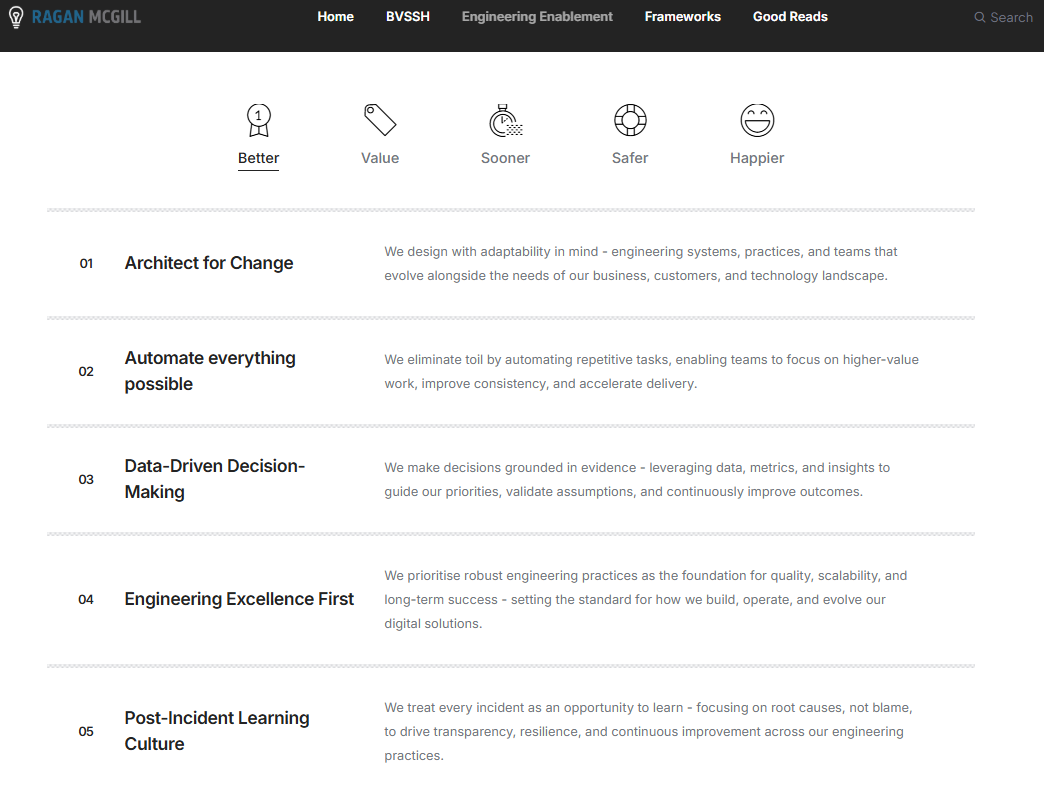Sooner Safer Happier - A Strategic Imperative for the Modern Organisation

Jonathan Smart's Sooner Safer Happier transcends the typical discourse on agility, emerging not merely as a methodology guide, but as a profound and necessary re-evaluation of how 21st-century organisations must operate. It's a powerful call to dismantle outdated command-and-control structures and embrace a values-driven, outcome-obsessed paradigm for navigating complexity and fostering continuous evolution.
For leaders weary of transformation initiatives that yield diminishing returns, plagued by siloed efforts and the creeping paralysis of delayed value delivery, Smart offers more than just a glimmer of hope – he provides a pragmatic and deeply humanistic lens through which to reimagine organisational effectiveness. This isn't another prescriptive framework; it's an invitation to cultivate a fundamental shift in mindset, anchored in systems thinking, the paramount importance of psychological safety, and an unwavering focus on tangible results.
The North Star: Impact Over Activity
Smart's central thesis is elegantly simple yet revolutionary in its implications: the relentless pursuit of outputs must give way to a laser focus on outcomes. He introduces a compelling constellation of leading indicators that redefine organisational health and delivery prowess:
Sooner: The imperative to deliver value with speed and frequency, shrinking feedback loops and accelerating learning.
Safer: Embedding quality, robust governance, and systemic resilience to mitigate risks proactively.
Happier: Cultivating an environment where satisfaction flourishes – for customers who receive valuable solutions, for colleagues who thrive in empowered teams, and for stakeholders who witness tangible progress.
Better: Continuously elevating engineering excellence, ensuring maintainability, and fostering a culture of relentless improvement in the craft.
Value: The unwavering commitment to ensuring that every delivered increment is meaningful, directly contributes to desired outcomes, and resonates with genuine customer needs.
These interconnected outcomes serve as a strategic compass, guiding organisations away from the performative rituals of "doing agile" towards a culture of evidence-based, value-centric transformation.
Illuminating Pathways: Patterns, Not Prescriptions
A key differentiator of Sooner Safer Happier lies in its astute avoidance of rigid, off-the-shelf solutions. Instead, Smart expertly curates a rich tapestry of patterns for success, drawn from a wealth of real-world experiences across diverse industries and scales. These aren't dogmatic rules to be blindly followed, but rather insightful starting points for context-driven evolution, fueled by iterative experimentation and continuous feedback.
These illuminating patterns include:
Leadership as Enabler: A profound shift from the traditional command-and-control model to one of coaching, mentorship, and empowering stewardship.
Governance by Principles: Establishing clear yet flexible boundaries through guiding principles, fostering autonomy within a framework of purposeful constraints.
Descaling Work: The art of dissecting complex initiatives into thin, vertical slices, dramatically reducing risk and accelerating the pace of learning through rapid feedback.
Measuring What Truly Matters: Moving beyond vanity metrics to focus on tangible indicators of flow, inherent quality, and demonstrable customer value.
Psychological Safety First: Recognizing that a culture of trust, where curiosity is encouraged and challenge is welcomed, is the bedrock of innovation and effective problem-solving.
These patterns act as catalysts, prompting leaders to critically examine their current practices and explore more effective ways of working.
Embracing Complexity: A Mindset Shift
At its core, Sooner Safer Happier champions a fundamental shift in organisational mindset – one deeply rooted in an understanding of complex systems, intellectual humility, and a heightened sense of interconnectedness. Smart compellingly contrasts:
Doing Agile: The superficial adoption of rituals, frameworks, and labels, often without a corresponding shift in underlying beliefs or behaviours.
Being Agile: An intrinsic state characterized by an unwavering focus on outcomes, a deep commitment to delivering value, and an inherent adaptability in the face of change.
This distinction is not merely semantic; it represents the chasm between fleeting, surface-level changes and deeply embedded, sustainable transformation. Organisations that merely do agile often find themselves trapped in legacy thinking, while those that genuinely are agile continuously evolve their perspectives, actions, and learning mechanisms. The book powerfully argues that organisations don't need more frameworks; they desperately need more empathy, greater clarity of purpose, and unimpeded flow of value.
A Vital Compass for Digital and Engineering Leadership (and a Personal Commitment)
For Heads of Digital Engineering, CTOs, and platform leaders, Sooner Safer Happier serves as both a potent diagnostic tool and a compelling roadmap for the future. Indeed, the framework has resonated so deeply that I've actively shaped my professional platform, www.raganmcgill.co.uk, around its core tenets. The website serves as a repository of digital engineering-focused articles, insightful policies, and practical standards, all carefully curated to align with the principles of delivering value sooner, safer, and with happier teams ultimately leading to better outcomes. This personal application underscores the practical and actionable nature of Smart's insights.
The book expertly exposes the often-hidden impediments to high performance – the drag of bureaucratic governance, the delusion of vanity metrics, the inertia of project-based funding, and the stifling effects of excessive risk aversion. In their place, Smart offers a more human-centric and adaptive model, one that actively cultivates experimentation, optimizes flow efficiency, and empowers the continuous delivery of value at speed and scale. In an era where digital agility is no longer a competitive advantage but a fundamental necessity, this book isn't just relevant – it's foundational reading, and its impact extends to shaping practical resources and approaches in the digital engineering domain, as evidenced by the focus of my website.
Concrete Actions for Leaders Driving Change
Smart doesn't just offer theory; he provides a set of actionable principles that leaders can immediately apply:
Redefine Success Metrics: Pivot from measuring activity (velocity, resource utilization) to tracking impactful outcomes: reduced cycle time, enhanced customer satisfaction, improved employee engagement, and demonstrable fitness for purpose.
Descale Work and Risk: Embrace incremental delivery. Break down ambitious goals into small, independent slices that facilitate rapid feedback and enable swift course correction.
Govern Through Principles: Replace cumbersome, control-heavy processes with lightweight, principle-based governance that fosters autonomy while maintaining essential guardrails.
Optimise for Value and Flow: Visualize and actively manage value streams. Identify and ruthlessly eliminate sources of delay, unnecessary rework, and crippling dependency bottlenecks.
Prioritise Quality (Better): Embed quality from the outset. Invest strategically in test automation, robust CI/CD pipelines, engineering excellence initiatives, and proactive management of technical debt.
Invest in Platform Thinking: Enhance the developer experience through the provision of reusable services, intuitive tooling, and robust infrastructure that reduces cognitive load and accelerates delivery cycles.
Cultivate Psychological Safety: Normalize the inevitability of failure as a crucial learning opportunity. Build a culture of deep trust, actively solicit diverse perspectives, and celebrate the insights gained from experimentation.
Enable Happy, Empowered Teams: Place a premium on team health and engagement. Recognize that high-performing teams are not only productive but also inherently more resilient.
Embrace Continuous Evolution: Treat organisational design and agility as living, breathing systems. Establish robust feedback loops and foster a culture of relentless adaptation and improvement.
A Human-Centred Operating System for Tomorrow
At its heart, Sooner Safer Happier isn't about scaling agile practices - it's about reshaping the very operating system of modern organisations. One that consistently delivers better outcomes, faster and more safely, while fostering happier, more engaged people. It challenges leaders to design for flow, lead with purpose, and build cultures that prioritise autonomy, psychological safety, and continuous learning.
Where Team Topologies offers a structural blueprint, Sooner Safer Happier provides the cultural and philosophical underpinnings. Together, they illuminate a path towards responsive, resilient, and human-centred ways of working - and this combined lens is core to how I’ve reimagined engineering enablement in my organisation.
Through www.raganmcgill.co.uk, I’ve taken deliberate steps to bring this framework to life:
- Organising articles, policies, and standards around the five BVSSH outcomes - Better, Value, Sooner, Safer, and Happier - creating an accessible, outcome-driven knowledge base.
- Designing a Centre for Enablement (C4E) rooted in this philosophy - one that provides thoughtful constraints and empowering guidance, rather than rigid control.
- Shaping our digital engineering standards with clear maturity models and measurable outcomes, enabling teams to evolve with autonomy while staying aligned on what good looks like.

It’s more than theoretical alignment - it's a lived, practical application of Smart’s principles. The work we’re doing through the C4E is helping to dismantle legacy thinking and create the conditions where engineering teams can truly thrive, continuously improve, and deliver meaningful impact at scale.
The c4e is shaped around policies, standards and practices ( read more here ) - with policies and standards, in particular, being aligned to the BVSSH framework. Practices and playbooks help level up standards, framework lenses provide insightful windows into tension (healthy) rich standards whilst compliance provides control through maturity models and measures. These all shape the _guard_rails and _guide_rails provided to teams (and potentially AI agents) to create solutions in service of outcomes.
#SoonerSaferHappier #DigitalTransformation #EngineeringLeadership #DevOps #C4E #PlatformThinking #PsychologicalSafety #ModernWork
Engineering leader blending strategy, culture, and craft to build high-performing teams and future-ready platforms. I drive transformation through autonomy, continuous improvement, and data-driven excellence - creating environments where people thrive, innovation flourishes, and outcomes matter. Passionate about empowering others and reshaping engineering for impact at scale. Let’s build better, together.
